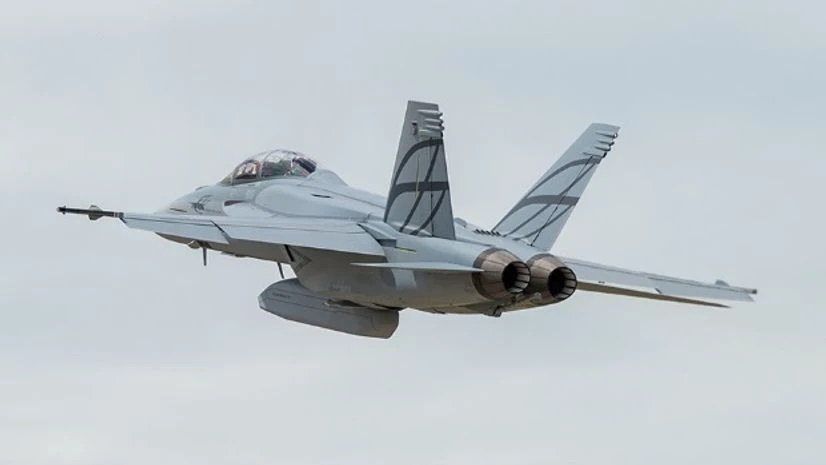There is a remarkable commonality between the Australian and Indian militaries in the high-tech US aircraft they have chosen. Both operate the C-17 Globemaster III and the C-130J Super Hercules transport aircraft. Both are users of the CH-47F Chinook heavy lift helicopter. India was a launch customer for the P-8I Poseidon multi-mission maritime aircraft (MMA), and now Australia has followed the suit. The first Royal Australian Air Force (RAAF) Poseidon will land here on Wednesday.
Now, with the Indian Air Force (IAF) initiating the international procurement of twin-engine fighters, airpower experts are waiting to see if New Delhi buys the F/A-18E/F Super Hornet, which is already the mainstay of the RAAF. The F/A-18 — an earlier version called the Hornet and the new, redesigned and upgraded Super Hornet — was developed by Boeing to operate off US Navy aircraft carriers.
The RAAF, however, operates them off land bases. The IAF will do the same if it chooses the Super Hornet over its rivals — the Rafale, produced by Dassault of France, and the Typhoon, offered by Eurofighter. The Indian Navy would consider the Super Hornet only much later, when its second indigenous aircraft carrier, INS Vishal, is being built in the 2020s.
The RAAF, however, operates them off land bases. The IAF will do the same if it chooses the Super Hornet over its rivals — the Rafale, produced by Dassault of France, and the Typhoon, offered by Eurofighter. The Indian Navy would consider the Super Hornet only much later, when its second indigenous aircraft carrier, INS Vishal, is being built in the 2020s.
Boeing, keen to dispel the impression that the Super Hornet is primarily a naval fighter, has invited Business Standard to interact with the RAAF about their Super Hornet fleet.
We enter the RAAF base of Amberley after an hour-long drive from Brisbane.
Group Captain Glen Braz receives us. Braz commands 82 Wing, which includes all of Australia’s 24 Super Hornets; from next year, he will also get a dozen F/A-18G Growlers — an electronically amped-up variant of the Super Hornet that accompanies fighters into combat to blind and confuse enemy radars and sensors.
Braz explains that the RAAF, which is in line to receive the fifth-generation Lockheed Martin F-35 Lightning II fighter, was constrained to buy Super Hornets. Given the F-35’s continuing developmental delays, Canberra assessed it needed a stopgap to “de-risk” the current decade. The decision was taken to buy 24 Super Hornets to supplement the RAAF’s 71 older Hornets.
“I was lucky enough to land the first Super Hornet on Australian soil in early 2010”, says Braz.
More From This Section
The group commander says the RAAF quickly realised that they had not bought a mere upgrade of the Hornet, but an entirely new, significantly more capable “Generation 4.5” fighter that was only a little short of the F-35. “While the Super Hornet looks like a (older version) Hornet, smells like a Hornet and flies a bit like a Hornet, the capability inherent in this aircraft is very remarkable and very different in that of the classic Hornet”, explains Braz. The RAAF promptly decided to extend the Hornet’s service life into the 2030s.
Braz believes the crucial differentiator between the Super Hornet and other fighters is its airborne electronically scanned array (AESA) radar — Raytheon’s APG-79. This is a multi-tasking radar, with one segment tracking enemy fighters and directing missiles onto them; another focused on identifying and striking ground targets; a third part jamming enemy sensors.
“You can switch instantly between air-to-air and air-to-ground mode; or between different weapons systems in the air-to-air mode. You can have four different weapons solutions on the same aircraft in seconds. It is a versatile and highly efficient fighting system”, enthuses Braz. The game, he explains, is all about seeing the enemy first and striking him at long ranges.
To achieve this, the RAAF has twin-seat Super Hornets, the pilot in the front seat flying the aircraft, while the weapons systems officer in the rear seat engages targets and exchanges data with other friendly aircraft through a coded digital link that connects every element in the battle-space. The IAF uses a similar two-pilot system in the Sukhoi-30MKI, but without such an effective data link, or an AESA radar. Other countries are now bringing AESA radars into service, but the US still enjoys a technological lead of a decade.
The RAAF also likes the Super Hornet’s capability to mount fuel tanks and act as a mid-air refueller. In a battle-space infested with enemy fighters, where an unarmed refueller aircraft could not survive, an armed Super Hornet can do the refuelling, extending the range of other fighters in a deep strike mission.
The induction of the Growlers next year is poised to multiply the Super Hornets’ effectiveness with formidable electronic warfare capability. The RAAF’s E-7A Wedgetail airborne early warning and control (AEW&C) aircraft would control the aerial battle, data-linking the Super Hornets, Growlers, Poseidons and, when they enter service, the F-35s.
Braz is particularly pleased about the Super Hornet’s “spiral upgrade programme” with the US Navy, for which the RAAF pays a share. This ensures that avionics and hardware upgrades carried out on US Navy Super Hornets are immediately shared with the RAAF.
For India, a decision to buy the Super Hornet would involve signing the Communications Interface and Security Memorandum of Understanding (CISMOA), an equipment security agreement with the US that New Delhi has steadfastly resisted. The US law requires key elements of the data networks to be protected by CISMOA.
Asked whether Australia accepted US safeguards on CISMOA-protected equipment, such as the positioning of US inspectors on Australian fighter bases, Glen Ferguson, Boeing’s maintenance manager, accepted that was essential.
“We comply with all the US requirements for safeguarding sensitive equipment. In many cases, we exceed the US requirements. It is in our own interest to do so”, Ferguson said.
The correspondent visited RAAF Amberley as a guest of The Boeing Company

)
